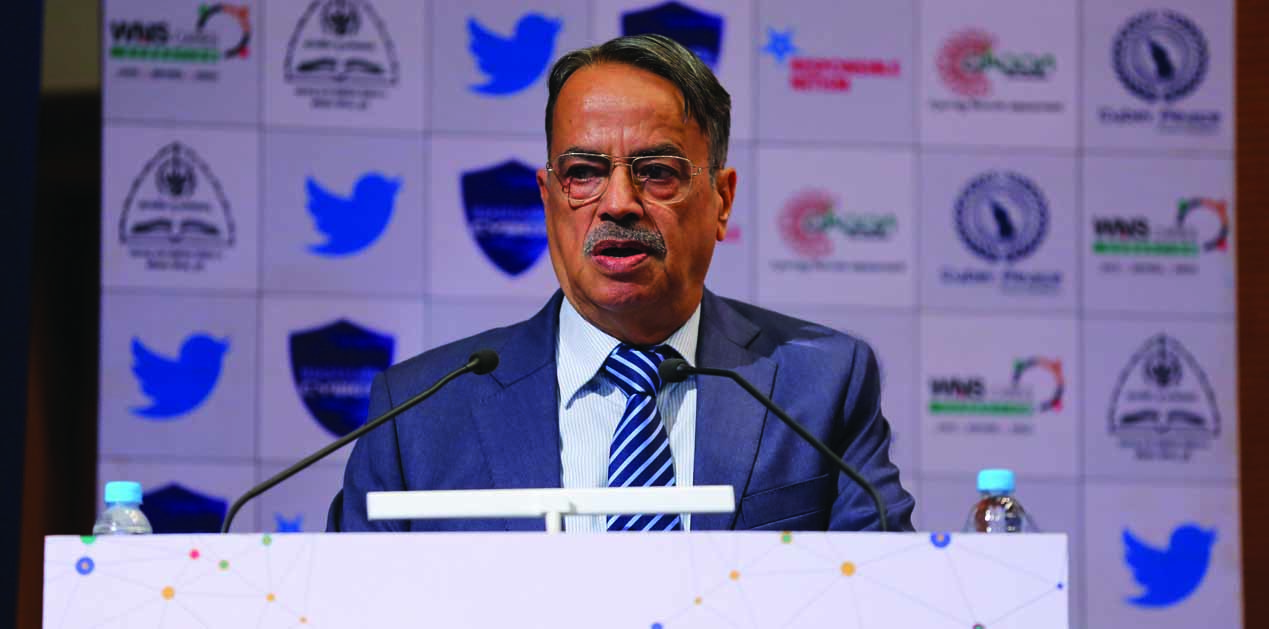(This is an updated version of the Valedictory Address given by the author during the Responsible Netism 4th National Cyber Psychology Conference 2020 on ‘Child Online Protection’ organized by Ahaan Foundation and Cyber Peace Foundation at Pune on 23-24 January 2020.)
Information technologies and mass media have altered the very experience of childhood today. The younger generations are more adept with high tech gadgets than parents themselves. This is as a result of the time and involvement of these young minds on digital platforms. These platforms offer a whole range of opportunities, provide abundant information and foster creativity. The number of internet users in children is staggering and further validated by the popularity of the kid-focused content online.
Youtube’s top earner is an eight-year old Texan Ryan Kaji who reviews toys and other childhood shenanigans. The third highest earner too, is a five-year old Russian. Research has shown that in Germany 67% of 10- to 11-year-olds already have their own smartphones, rising to 88% for 12- to 13-year-olds. Similarly, in Britain 83% of 11- to 12-year-olds and 96% of 13- to 14-year-olds have their own phones1.
The International Journal of Preventive Medicine, in a report has observed 95 per cent of children in India live in homes with a mobile phone and 73 per cent of Indian children are mobile phone users. Further, 70 per cent of these fall under the age group of 7-10 years, whereas 76 per cent are in the age group of 11-14 years2.
Internet is increasingly being used as the medium to address the inadequacies in the formal education system. These e-learning platforms further promote children’s need and importance to use technology platforms for learning. This results in parents, at times, casually passing their handsets to their children, as it is often a convenient and legit pass time for them. What parents tend to miss out is that the learning will only be as effective as their guidance and supervision of their children’s online activities. Even as all these resources adds to the overall development of children from a very young age, the real concern, as discussed during this conference, has been around the heavy dependency and obsession which the children are developing for this virtual world.
The ill-effects of this overdose in the virtual world are not new to anyone today. The most obvious one for the children is the health disorders with a cut down in physical and social activities. There is now a new psychological disorder known as Screen Dependency Disorder that is associated with obsession with internet usage.3 Such like afflictions because of overuse of internet have adverse effects on a developing mind. On the other hand, teenagers hooked to social media are easy targets for the perpetrators of cybercrime. Internet has also given rise to a variety of cybercrimes against children. Such criminal conduct includes cyber bullying, cyber stalking, defamation, online child trafficking as also some harmful games and challenges leading even to commit suicide.
Youngsters raised on the current setup of learning enroll to a formal setup with a very different set of ‘literacy’ skills from even a decade ago. Thus, it stands to reason that early childhood educators need to reevaluate their own developmental and literacy expectations of the children growing up in the current environment of digital learning and experiences. More importantly, it requires a change in attitude: new electronically mediated ‘reading’ and ‘writing’ skills are different in kind –not qualitatively inferior or ‘less’ than traditional print literacy skills.
One study across ten OECD (Organization for Economic Cooperation & Development) countries found that a quarter of all young people had a mental disorder4. And heavy users of social media and video games often suffer from sleep deprivation, which seems to be associated with anxiety and depression. In a recent survey on smartphone and internet addiction, the South Korean government put the share of three- to nine-year-olds at high risk of addiction at 1.2% and that of teenagers at 3.5%5. The term “internet addiction” (IA) has been used to define psychological dependence on the internet. Many other types of psychiatric disorders are said to be associated with IA today.
It also needs to be noted that first Internet de-addiction center came up in the USA in year 2009 whereas the first such center came up in Bengaluru in mid-20146 which was closely followed by opening of IA de-addiction center in Delhi in July 20147. Maharashtra got its first IA de-addiction center in 2018; as of now many more are opening up in India’s major cities. This only shows that overuse of internet and its adverse effects, especially on children and teenagers have assumed critical proportions.
Internet provides a fertile ground for a variety of crimes that are being committed against children; this phenomenon is extremely disturbing and widespread today. There is a murky world of online criminals that targets young minds globally. Technology allows perpetrators to act anonymously, while providing them the access to a large, vulnerable population of children. Media platforms such as WhatsApp, Facebook, Instagram, TikTok and Snapchat are easy targets for the perpetrators of cybercrime. Cyberbullying is also becoming more and more prevalent amongst children. People on social media try to make their lives seem more glamorous than they really are, which brings a lot of anxiety and depression for some who don’t gain that attention from their peers. Wittingly or unwittingly children do get an access to disturbing content – that might include adult pornography, violent images and suicide sites – but what seems to bother them most is when other children post or say hurtful things about them, hate speech and discrimination.
Another dire consequence of this media influence has been the viral content about self-harm or suicide. Many online games have been circulating on the internet which have encouraged children to view suicide as a viable way to deal with their problems, or even romanticise or glamourise the act of suicide. There are games/challenges like the Blue Whale and the Momo challenge that gained popularity the world over. The Momo game first surfaced on YouTube Kids and then on other digital platforms. It basically asked the players to inflict self-damage (and record it at every stage) and in the final stage, it asks the participant to commit suicide. This challenge reached all the way to Ajmer in India, where a 16-year-old, Std X student hanged herself as, allegedly, she had reached the final stage of a dangerous online game.
Such events have brought to the fore, low levels of digital literacy amongst children. It also highlights the critical role that parents need to assume to protect their children from such overwhelming experiences online. We must together help our children discern and avoid online gaming or social communities that could present risks of suicide contagion.
Parents need to frequently engage in conversation with children to find out what they have been watching, playing or who they are be-friending online. In the absence of such an offline environment at home, children also fall prey to cyber grooming.
Typically, pedophiles, these groomers fake an identity to befriend children and take of them for sexual purposes. With platforms like TikTok making child selfie-videos so accessible, helping them become social influencers, the chances of their getting lured into sexual abuse rackets are all the more apparent now.
The clear change in a child’s behavior at the time of such happenings must send the parents in an alert mode. Although, while getting to the root of a child’s unusual behavior over a period of time can further isolate them from the family, if parents appear to be too strict and judgmental. Hence it needs to be done in a very balanced way. In cases of hyper-vigilancy, parent’s anxiety often gets transferred to their child’s anxiety and worsens the matter. Therefore, its important for parents to really act as grown-ups while dealing with the younger lot.
With these kinds of threats looming over their future generation’s well-being, the governments can of course no longer be detached from the matter. Governments across the globe have made legislative amendments to fight the menace of cyber-crimes against children. For instance, in Europe there has been a shift from “safer” to “better” internet. The United States Department of Justice's Office of Juvenile Justice and Delinquency Prevention has formed a task force known as Internet Crimes Against Children (ICAC). South Korea, with one of the world’s most highly connected societies is seriously looking into the over-use of internet among both children and adults. They have come up with a campaign that encourages the population to “turn off media, turn on life”. The international organisations involved in Internet governance processes have not systematically recognised the distinctive rights and needs of children as a substantial group of Internet users.
In India, cyber laws are applicable to cyber-crimes against children but there is rising need to consider the severity of these crimes on a societal level. Laws like The Protection of Children from Sexual Offences (POCSO), the Information Technology (IT) Act, the India Penal Code (IPC) and the Juvenile Justice Act are some of the legislative measures to safeguard children against cyber-offences. However, there is a strong need for better laws, better technology and accountability on the part of intermediaries such as Facebook Google, etc. Recently, a Rajya Sabha panel has recommended expanding the definition of online crimes and sexual abuse against the children as also to make changes in the law to make punishments more stringent8.
The regulatory mechanisms overlooking the content on digital platforms should especially focus on safeguarding children from inappropriate content. Additionally, filters and reporting tools can help the parents in supervising their child’s online activity.
It is important to direct a child’s curiosity towards growth and creativity. Hence more of such initiatives and ideas must be promoted by big technology companies. Rightly brought up by some of the activists, HRD ministry must intervene to make social media studies a part of the curriculum and must educate children and parents on the pitfalls of living online and the need to respect privacy.
It is of utmost important to understand that parents are the first and the most important link in this chain of guardians. They can directly inspire the way their children will navigate the cyber space. Education institutes too can contribute significantly to the cause. These can be important awareness measures to guide the innocent and vulnerable young crowd. But this needs to be supplemented with a moderate exposure to these kinds of tools at home. Until the parents instill time-focused rules for the kids, they will never quite succeed in their motive. Discipline needs to find its rightful place in the family, even as parents become a close confidante of their children.
Further some NGOs along with the National Commission for Protection of Child Rights (NCPCR) have evolved a ‘Legal Toolkit: Child Victims of Cybercrime’ to address the existing knowledge gap on cybercrimes9. It also attempts to clarify the law surrounding the issue by providing precedents, case studies and analysis as examples of the current methods incorporated by the investigating forces to handle cybercrime cases.
Through initiatives and toolkits like this we can be effective digital guardians for the young and bright minds of our country. As responsible netizens, we must ourselves with by example and bring in a sense of digital consciousness in our surroundings. There must be concerted global efforts, through existing bodies like International Telecommunication Union (ITU) and others, to build the resilience and digital literacy for our next generation users of ICT technologies.
India’s Ministry of Home Affairs has a Cyber and Information Security (CIS) Division since October 2017; one of its many tasks is to have a detailed plan for prevention of cybercrimes against women and children as also coordinate with a host of other agencies in dealing with cyber-crimes. However, it is quite evident that a whole of government, people, and parents/guardians approach is needed to prevent and reduce the incidence of online crime against the children. Civil Society Organizations have also proved themselves to be very useful in promoting awareness of this malaise and how to counter it. There is also need to remove the offensive content from the internet and here internet companies have to their bit; in fact the governments should effect legislations to ensure the same. Further, the capacities of police and cyber forensic professionals would greatly help in mitigating prevalence of cyber-crimes against children. And finally, improving knowledge and attitudes of children and adolescents would continue to remain an important aspect to be addressed by parents, guardians, educators and the government.
End Notes
- Amy Packham, “Nearly 20 % of Five to six year olds own a mobile phone”, Huffington Post, 31 January 2018 available at https://www.huffingtonpost.co.uk/entry/kids-mobile-phones-activities_uk_5a708015e4b05836a2569da0
- Priyanka Sharma, “Kids addicted to electronic screen susceptible to obesity, diabetes”, April 28, 2019, India Today available at https://www.indiatoday.in/mail-today/story/kids-addicted-to-electronic-screens-susceptible-to-obesity-diabetes-1511877-2019-04-28
- Ibid.
- OECD Report of 2018 on “Children and Young People’s Mental Health in Digital Age: Shaping the Future”, available at https://www.oecd.org/els/health-systems/Children-and-Young-People-Mental-Health-in-the-Digital-Age.pdf.
- Special Report by The Economist on “How Children Interact with media” January 03, 2019 available at https://www.economist.com/special-report/2019/01/03/how-children-interact-with-digital-media
- Seethalakshmi S “Helping Junkies to Log Out: India’s First Net De-Addiction Centre”, Jun 22 2014, The Times of India, available at https://timesofindia.indiatimes.com/home/sunday-times/deep-focus/Helping-web-junkies-log-out-Indias-first-net-de-addiction-centre/articleshow/36986878.cms?utm_source=contentofinterest&utm_medium=text&utm_campaign=cppst
- Durgesh Nandan Jha, “Delhi gets its first internet de-addiction centre”, July 22, 2014, The Times of India available at https://timesofindia.indiatimes.com/city/delhi/Delhi-gets-its-first-internet-de-addiction-centre/articleshow/38824454.cms
- Ambika Pandit, “RS panel for Pocso Act tweaks to shield kids from online porn”, 04 Feb 2020, The Times of India, available at https://www.pressreader.com/india/the-times-of-india-mumbai-edition/20200204/282046214085389
- “Explained Everything: What you need to know about protecting kids from Cyber Crimes”, 05 April 2018 available at https://www.youthkiawaaz.com/2018/04/cybercrimes-against-children/
(The paper is the author’s individual scholastic articulation. The author certifies that the article/paper is original in content, unpublished and it has not been submitted for publication/web upload elsewhere, and that the facts and figures quoted are duly referenced, as needed, and are believed to be correct). (The paper does not necessarily represent the organisational stance... More >>











Post new comment